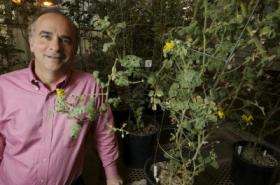Figuring out green power -- scientists speed up discovery of plant metabolism genes

Michigan State University researchers are dramatically speeding up identification of genes that affect the structure and function of chloroplasts, which could lead to plants tailored specifically for biofuel production or delivering high levels of specific nutrients.
Chloroplasts, which are specialized compartments in plant cells, convert sunlight, carbon dioxide and water into sugars and oxygen ("fuel" for the plant) during photosynthesis. Chloroplasts also synthesize nutrients such as starch, amino acids, antioxidant vitamins and lipids, which are important to humans and other animals.
"We're using this advanced technology to capture information on almost 100 traits, with an emphasis on metabolism," said Rob Last, MSU professor of biochemistry and molecular biology. "We can then analyze that data and look for correlations that we wouldn't see using traditional genetic screening methods. Finding these correlations gives us a more complete understanding of the relationships between seemingly unrelated aspects of plant metabolism."
Last and his colleagues use high-throughput genetic screening and advanced analysis technologies for their research. He discussed that technology, as well as the possible biotechnological outcomes, at the American Association for the Advancement of Science annual meeting today.
Manipulating plant metabolism to create crops with more biomass or improved nutrition has been hampered by limited information on how metabolism works -- metabolic pathways are more complex than scientists realized. High-throughput genetic screening allows scientists to look at the effects of genetic changes with a much broader lens than traditional screening technology. Last said it's akin to looking at a traffic problem in a very small town compared to a big city.
"A genetic mutation is like a traffic jam," he explained. "If you block off Main Street in a rural area, there are a limited number of roads and possible detours, and it's likely that everyone will take the same detour. That's the way traditional screening looks at genetic changes, with a focused, close-up perspective," he explained. "But if you block off Michigan Avenue in Chicago, there are many detours people could take. Using high-throughput screening allows us to step back and look at all these detours, rather than focusing in on just one. It gives us a more complete view of the effects a genetic change can have."
The knowledge that Last and his colleagues discover about the genes involved with plant metabolism may be used to create plants that have more biomass that could be used for biofuels, or plants that contain higher levels of beneficial nutrients such as unsaturated fats or fiber.
Source: Michigan State University















